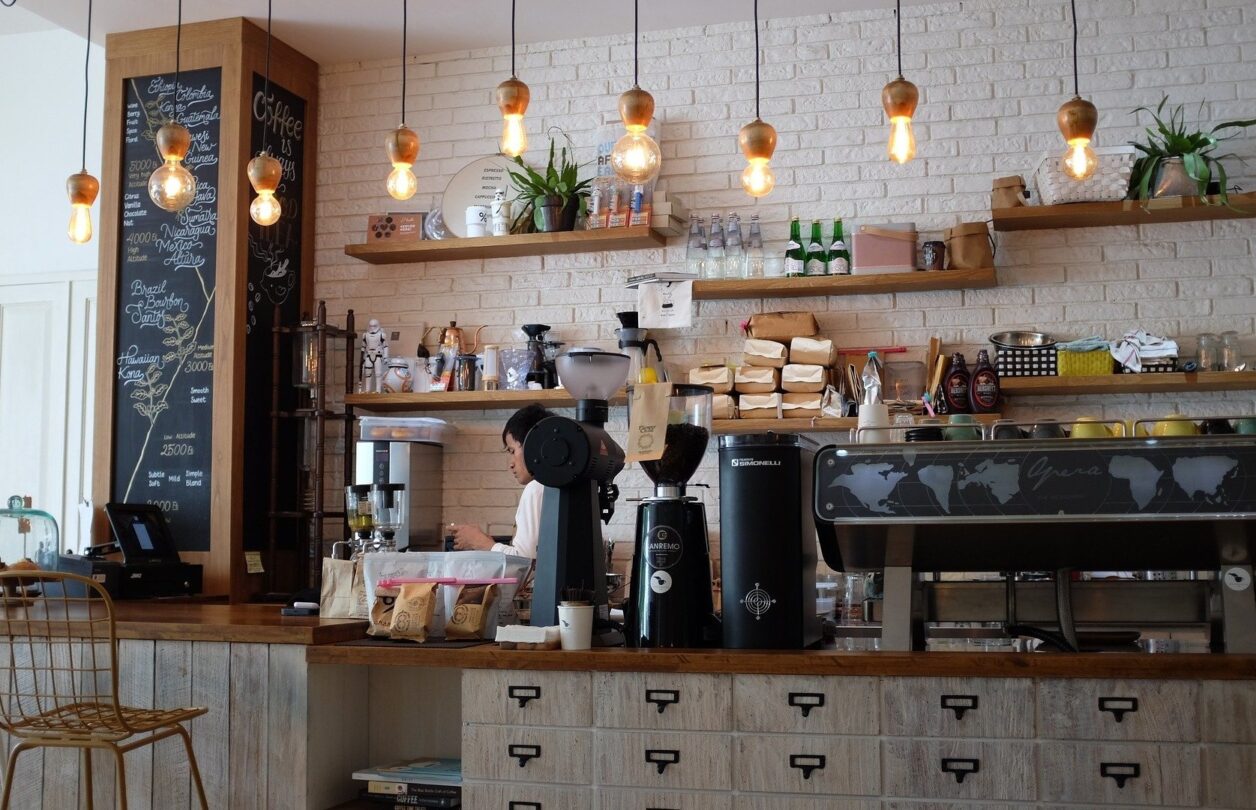Your essential guide to managing a café or coffee shop
Running your own coffee shop might sound like a piece of cake, but what do you need to know before you get up and running? Time to find out.

With spending at coffee shops in Britain hitting around £3.9bn in 2019 according to market researchers Mintel, it’s little wonder that the idea of owning a coffee shop and running it yourself has never looked more attractive.
As more people enjoy flexible working, working from home and strolling to their local barista for a mid-morning caffeine break, and look forward to catching up with friends over socially distanced cappuccinos or holding casual work meetings with a latte in hand, that consumer spending and market growth seems set to continue.
A recent report on bars and cafés forecast that global spending in the sector is set to hit £294.4bn in 2021 with a compound annual growth rate of 20.3%.
The positive news comes as businesses the world over are seeing the effects of pivoting their operations to meet the challenges presented by coronavirus, and takes into account the fact that more disposable income will be fed into the industry as restrictions ease and markets stabilise.
Research published in July 2019 by the World Coffee Portal reveals that there were 7,022 independent cafés operating in the UK, with an estimated value of £2.4bn.
The same report also reveals a 4% annual outlet growth for UK independents over the previous 12 months. The research forecasted that the segment would exceed 8,000 outlets by 2024.
Of course, as this research was carried out pre-pandemic, it’s fair to assume that this number is not as high as before. However, consumer behaviour suggests a burgeoning market is there for you to tap into.
So what does all of that translate to? One thing: opportunity.
This article highlights what you need to do to successfully manage a café or coffee shop. Here’s what it covers:
Running your own coffee shop: What’s your niche?
Plan for success – and have back up plans
Café management costs at a glance
Getting the word out: Promoting your café
Getting started
Stuart Wilson co-founded Lost Sheep Coffee in 2012 with his partner, Sarah, after the couple returned from a backpacking tour of Asia and Australia.
They decided there could be a market in Kent for the kind of high-quality speciality coffee that they’d enjoyed while living in Melbourne.
The business started life with a loan for £10,000 and a three-wheeled coffee van.
They took just £30 on their first day but now, following further investment, have two outlets and are the largest speciality coffee roastery in Kent with an annual turnover in 2019 topping £750,000.
And they’re still thriving, even with the challenges of the pandemic rippling through the country.
Before you take the first steps towards running your own coffee shop, it’s a good idea to get some practical experience of the business by actually working in one.
Organisations such as the London School of Coffee and the Artisan Coffee School offer barista training.
But even if you don’t decide to train up, then just taking orders, clearing tables, working the till, or even sweeping and clearing up at the end of the day will help you pick up useful tips and insights into this world.
When you’re running a coffee shop, as with any other business, hands-on experience is absolutely invaluable.
Running your own coffee shop: What’s your niche?
Before you run a place of your own, it’s essential to identify your niche, because that’s going to have a direct effect on every part of your business, from customer service and coffee shop management to the products you sell.
What kind of café do you want to yours to be? Is it a co-working space for busy freelancers?
A vibrant, family friendly place? A taste of Paris, complete with fresh croissants and delicate macarons?
You’ll need to be clear on what your identity is when it comes to branding, deciding on a name, and figuring out your interior design complete with furniture and crockery.
Do some competitor analysis. Look at what other coffee shops around you are offering, and how much they’re charging.
Who are their customers and when are they busiest?
This will help you get a feel for the market and help to identify if there’s a gap in it that only your business can fill.
Plan for success – and have back up plans
Just as you would with any new venture, you’ll need to put together a detailed business plan for your café, ideally with help from your accountant or your bank.
As well as including all the outgoings and money coming in, create a number of what-if scenarios and figure out a plan of action for each.
What if you only make £50 in your first few days? You need to factor in different levels of customer interest and the possibility that you might need further cash injections.
You’ll probably want to offer discounts and freebies to promote your brand when you first open.
Err on the side of caution and assume it’ll take you a few weeks to get into the swing of things, and let word of mouth work its magic.
Your business plan needs to take into account overheads, including details of all costs from staff and rent to raw materials, utilities, and other fixed or variable costs.
Staff costs should be no more than a third of your turnover, at least not more than half of your shop’s total overheads.
Your accountant or bank manager can then help you to check costs, forecast revenue projections, and test the assumptions you’ve made, so don’t be afraid to get in touch for some guidance.
In a post-pandemic world, you also need to think about how restrictions could impact your business and come up with a plan to navigate those choppy waters accordingly.
The ‘new normal’ might even inspire you to run a 100% mobile business, or an app-order only setup. Don’t be afraid to get creative with your business offering and think outside the bricks-and-mortar model.
Consider the number of covers you can accommodate at 50% capacity, your health and safety practices, and your e-commerce offering – three crucial points that could keep your business afloat in difficult times.
Café management costs at a glance
Startup costs for coffee shops vary greatly, with the minimum you need to get up and running typically around the £10,000 mark, depending on the size and location of your shop plus the decor.
Commercial espresso coffee machines can cost anywhere from £1,500 to £10,000.
Leasing them will allow you to ensure that you’ve got the latest model and will help you to manage cash flow more effectively, so be sure to factor that into your café business plan.
Cash flow management is one of the main challenges that can come with running a coffee shop, especially if this is your first time in business.
Tracking your cash flow is an important task. By using good cloud accounting software aimed at the hospitality industry, you can stay on top of your numbers.
Be prepared to work very long hours, even when you have staff.
You’ll often have to be in the shop early to open up and prepare for customers on their way to work. And after you close at the end of the afternoon or evening, there’ll be myriad jobs to do.
Weekends are, of course, also busy days for coffee shops.
Finding staff who are hard-working, customer focused and honest in an industry where wages are low and turnover high is another challenge.
So think about how you can hire and inspire a team of trusted employees to help your business thrive.
The café sector is an increasingly competitive business, but the push to shop local and support small business that came with the pandemic will continue to work in your favour.
The arrival of one new coffee shop near you might increase footfall in the locality. And having one of the big chains open around the corner will act as a foil to your friendly neighbourhood indie offering when it comes to your marketing.
But competition can be fierce, and the arrival of other coffee shops and food outlets is something you need to be aware of if you want to keep customer numbers high.
Location and layout
It’s worth remembering that if you add to or change the food and drinks that you’re offering, or launch other services in-store, you might need to check the use class of your property.
As you might have discovered when you signed the lease, the Town and Country Planning (Use Classes) Order 1987 allocates something called ‘use classes’ to buildings.
Restaurants and cafés come under use class A3, while hot food takeaways are, for example, A5. You might need to get legal advice as your offering evolves.
Making sure that the number of tables and chairs, as well as your staffing and coffee-making facilities, are appropriate to the space you have and number of customers you plan to cater for is also important for maintaining good customer service.
A small coffee shop might be around 500 to 1,000 square feet, which provides space for anywhere between 15 and 45 covers, assuming that people are sitting in.
For around 50 to 100 covers, you’ll need about 1,000 to 2,000 square feet.
And 100+ covers require something over 2,000 square feet, and so on and so forth.
Matching customer numbers to facilities and staffing is vital to keeping your customers and employees comfortable and keeping your business profitable.
Entrepreneur Anette Megyaszai had been running a successful wholesale patisserie business when she decided to open Chateau, a coffee shop in Chiswick, west London.
“It was the location that made me want to do it,” she says. “It was on a corner and we realised that it would be great to have something customer facing for our business.”
It took four months to negotiate the lease and another two to kit the shop out. Anette soon found the experience of running a coffee shop was very different to producing cakes and desserts for others to sell.
“To get customer service right, to make sure that the coffee is just perfect, and the patisserie is beautifully presented and people feel welcomed, it’s essential to have the right team,” she says.
“Some staff might have a great CV but it’s only when you see them in action that you know whether they’re right or not.”
Getting the layout of the shop to work properly was another learning experience for Anette. She moved the kitchen downstairs, transferring the extra seating to the ground and first floor.
“I’d definitely recommend a single floor,” she says. “Otherwise, you actually need an additional member of staff with all extra costs that entails, to bring food and drinks up and downstairs.
“Having one floor also means that you can keep an eye on everyone.
“When you start off you want to please your customers, but the truth is that you can’t have book groups or people running business meetings for two or three hours upstairs and just buying one cup of coffee during that time.”
Creating a quality product
Then comes the coffee itself.
Quality and consistency are watchwords for Stuart Wilson at Lost Sheep. “We weigh and time the coffee for each and every cup we make,” he says. “We will never let the milk get above 64 degrees Celsius when we heat it.
“You must make your coffee to a recipe. We start with 18.5g of coffee grounds and 36g of espresso extraction and aim to have it pour at 30 to 34 seconds.
“That means whether it’s me or any other barista crafting a coffee for you, you’ll know exactly what you’re going to get.
“My advice is never to cut corners, do not be tempted by cheap coffee with no traceability. Always challenge your supplier about where it’s from.
“A great coffee roastery will be able to tell you the exact region it was grown in as a minimum.”
To ensure the quality of the product, Lost Sheep Coffee now roasts its own.
Traceability is another key selling point for a small, independent café according to Stuart, who started his career in banking before training in Melbourne as a barista.
He says: “We aim to source over 75% of our raw ingredients from within 20 miles of our shops. People love knowing where their food has come from.
“In addition to this, we can trace all of our coffee beans back to the farms and fields they were grown on. How many coffee companies can do this?”
So if you have something to say about the sustainability and traceability of your product, or the way your beans are specially roasted, shout about it on social media and across all your marketing touchpoints.
The average customer is more eco-conscious than ever before, and an increasing number of people want to know where their favourite cup of coffee comes from.
Finding the right suppliers
Using local suppliers has an additional advantage.
“If you’re advertising them, then they’ll advertise you in return and word gets around,” says Stuart.
Anette also recommends getting exclusivity wherever possible when it comes to what your coffee shop sells.
Negotiate these deals with suppliers so that your customers won’t find that the same food and bottled drinks you offer are available just down the road.
Keeping in regular contact with your suppliers and providing constructive feedback on product quality and prices is key.
Collaborate with your contacts and make time to meet them face to face on a regular basis, either at their premises or yours.
This will also help you keep your finger on the pulse of the business and stay on top of what is happening in the market.
Your coffee supplier might know a great cake maker, for instance. Even if you’ve been working with them for some time, it’s useful to consider how you can team up to develop new products or make their existing offering even more suited to your clientele.
Finally, and perhaps it goes without saying, pay your suppliers on time to keep the relationship positive and friendly.
Getting the word out: Promoting your café
Partnering with other local businesses by providing free coffee in exchange for on-site advertising will help to get the word out.
Given that most of your clientele will be local, consider putting flyers through doors with promotional coupons.
Get in touch with newspapers and radio stations in your area to tell them about your exciting new opening, complete with exclusive special offers for readers or listeners.
You can also offer yourself as a case study of a local business whenever they’re looking for comment about issues relating to the economy in your part of the country.
Stuart adds: “The other type of promotion that’s been essential for us is social media. It’s free and easy. If you’re unsure on what to do, there are thousands of videos on YouTube with advice on how to photograph food well.
“It is that important to our business that we now have our own social media specialist in-house.”
Once you’ve attracted your customers, keep them coming back with a loyalty card.
But don’t rest on your laurels.
Take it from Anette, who says: “Your business needs to be constantly evolving new ideas and new offers to keep people interested and to attract new customers.”
One way to develop these new ideas is to subscribe to the growing number of coffee shop trade media.
Roast magazine, for instance, “addresses the art, science and business of coffee”. Meanwhile, Barista magazine has the latest news on barista art as well as insights into the coffee sector.
Last but not least, the World of Coffee Portal focuses on the business of coffee and coffee shops.
As well as continuously checking on what products are selling and when they’re most popular versus those that don’t move as fast, you can also put suggestion boxes in prominent places around the shop or use social media to invite your followers to share their thoughts on all things café.
You can run a poll on Instagram, for example, asking your audience which breakfast item is best, or which pastry is better, croissants or pain au chocolat?
Get your customers engaged in the way you run your business. Ask your staff about what they observe, too.
But the best way to keep up with trends is simply to take a few moments to talk to your customers while you’re serving them. This is one advantage that you, as an independent, have over the big brands and the best way to keep your coffee shop business buzzing.
Business plan template for food and drink companies
Want to create a business plan for your food or drink company but not sure how to do it? Download our free and easy-to-use business plan template and you can get started.







Ask the author a question or share your advice